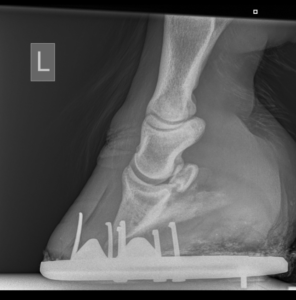Does my horse have laminitis is frequently asked question. It is unfortunately a commonly encountered painful disease and seen far too often.
Anatomy of the hoof
Let’s quickly go through the anatomy of the horse’s hoof. Internally, the hoof contains the pedal bone (P3) and the navicular bone. The laminae stick the hoof wall to the pedal bone and transmit all the weight bearing forces from the limb to the ground. In laminitis, these laminae swell and start to break down weakening this bond between them. This can ultimately lead to the pedal bone rotating away from the hoof capsule, and in some severe circumstances cause the pedal bone to drop within the hoof capsule. As you can imagine, this is very painful and is a huge welfare issue for the horses and ponies affected with this disease.
What are the causes of laminitis?
There are three main causes of laminitis:
- Hormone (endocrine) related diseases – Cushing’s disease and EMS (Equine Metabolic Syndrome). Futher information on these diseases can be found here
- Mechanical overload eg when one limb has a fracture the other limb bears all the weight of the horse
- Inflammatory diseases such as retained placenta, severe diarrhoea, pneumonia
What are the signs of laminitis?
- Lameness on at least 2 limbs
- Heat in feet
- Increased digital pulses – do you know how to take your horse’s digital pulse?
- Leaning back on heels
- Shifting weight around feet
- Divergent hoof rings
What should I do if I suspect my horse has laminitis?
The first thing to do is get your horse or pony in from the field and call your vet. Bring them into a stable that has a fresh, deep bed that covers the whole stable floor right up to the door. Ideally the bedding should be supportive as possible – shavings are a good type of supportive bedding. Based on what your vet finds, it’s likely your horse will be on box rest for a period of time, so it is important to provide easily accessible fresh water and hay.
How does my vet diagnose laminitis?
Your vet will examine your horse initially. They will look at them move (if possible), and palpate the hooves and digital pulses. The may also apply hoof testers to the soles of the hooves to determine if there is a pain reaction in front of the frog. The vet may also want to take some xrays of the hooves to determine if there has been any movement of the pedal bone. They may also want to take some blood samples if they suspect a hormonal condition such as Cushing’s disease or EMS, is underlying.

What treatment will my horse receive for laminitis?
Equine laminitis should always be classified as an emergency so that the horse can receive medical treatment as quickly as possible. Many types of drugs can be used in the treatment of laminitis. The main immediate issue is to provide pain relief. This can be given in the form of ‘bute’, finadyne or meloxicam. Some horses may require even stronger painkillers such as morphine or fentanyl. Nowadays we also often give paracetamol to horses suffering from laminitis in addition to these other painkillers. In some instances vets will prescribe a low level sedative called ACP (sedalin or relaquin). This helps keep the horse calm, can sometimes encourage them to lie down which relieves pain by taking the weight off the feet, and also it has been shown to improve circulation to the hoof by causing vasodilation.
If your vet suspects that your horse/pony is suffering from Cushing’s disease (PPID) or EMS they will carry out tests to confirm this. If either disease is confirmed medication may be prescribed to help control the underlying disease contributing to the laminitis. We have an excellent blog on Equine Cushing’s Disease and EMS here.
The horse will also require support to the hooves. This is often applied as a frog support such as a lilypad, styrofoam pads, or rolled up gauze which are then taped to the hoof. This allows weight to be distributed to the back half of the hoof. This removed weight from the front part where most of the damage and pain comes from.
As previously stated, your horse will now be on a period of box rest. This will be very individual to each case. This stops the horse moving on their hooves and doing further damage. It also encourages them to lie down more often. While on box rest dietary changes can also be made especially if your horse/pony is overweight. Weight loss is very important in overweight horses but must be done in a steady controlled manner.
What should I feed my laminitic horse?
All concentrates should be removed from the diet and the horse should be fed rationed/weighed hay. If trying to achieve weight loss, the initial amount of hay to be fed should be equivalent to 1.5% of your horse’s body weight e.g. a 500kg horse is fed 7.5kg hay in 24 hours to help aid weight loss. Soaking the hay allows more sugars to be removed from the hay and is therefore safer for horses to eat that are unable to handle sugar well. Haylage should be avoided due to it being much more palatable and therefore consumed in greater quantities. DO NOT feed concentrates, molassed chaff or molassed sugar beet.
How long will it take my horse to recover from laminitis?
There is very much an individual response to this disease and can be from several weeks recovery to several months. You will be guided by your vet on how well your horse/pony is doing and they will be able to give you a rough idea to how long they think your horse will be on box rest.
Unfortunately once your horse has had laminitis, it is common for them to have recurrences. Laminitic horses and ponies need to be well managed with regards to any underlying diseases, feeding and exercise. However, as long as they recover and are managed well, they can still lead a normal life and return to all the their previous activities.






